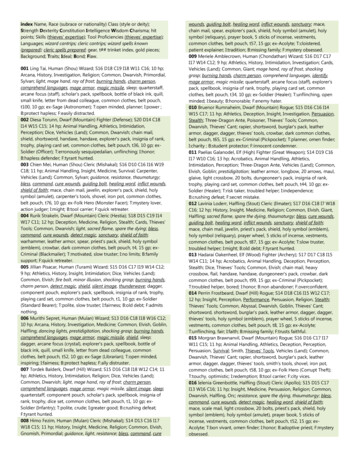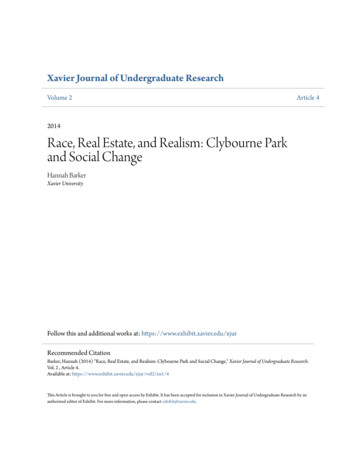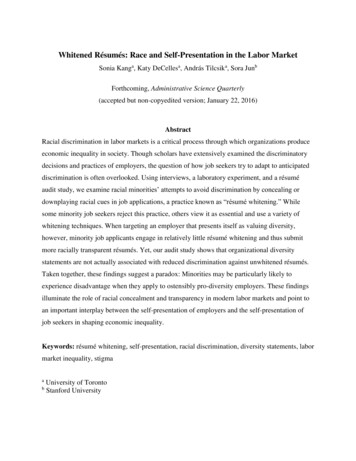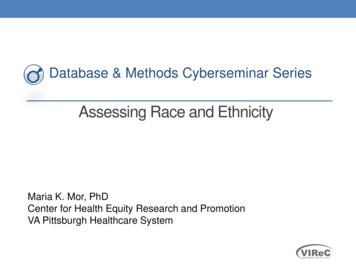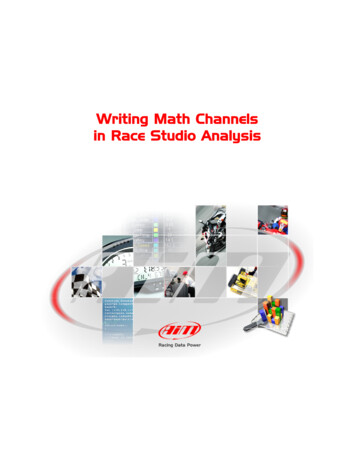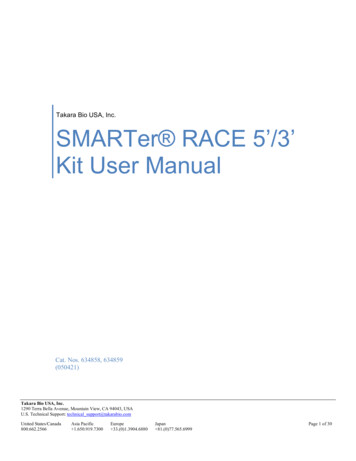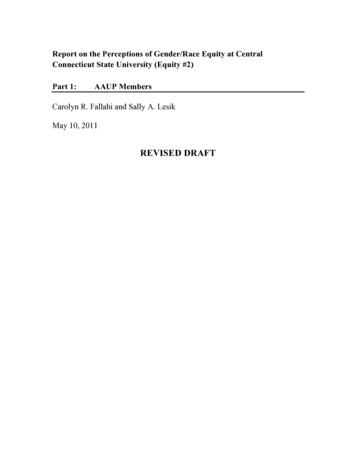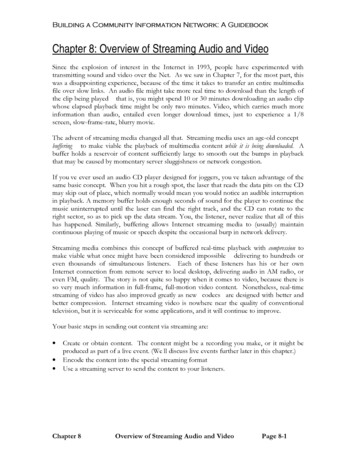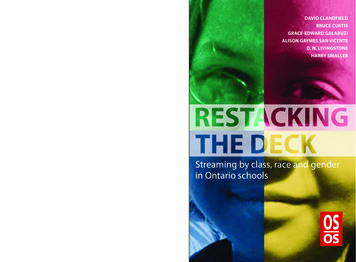
Transcription
DAVID CLANDFIELDISSN 0840-7339ISBN 978-1-77125-016-0BRUCE CURTISOur Schools/Our Selves is a quarterly journal on educationpublished by the Canadian Centre for Policy Alternatives (CCPA).To subscribe to Our Schools/Our Selves, contact:Canadian Centre for Policy Alternatives @250ne Community500-251 Bank St., Ottawa, ON, K2P 1X3Tel: 613.563.1341 Fax: ternatives.caGRACE-EDWARD GALABUZIALISON GAYMES SAN VICENTED. W. LIVINGSTONEHARRY SMALLEROUR SCHOOLS/OUR SELVES V.23 N.2 (#114) WINTER 2014“Will we waste another generation?” This is the question posed inStacking the Deck: The Streaming of Working Class Kids in OntarioSchools, published more than 20 years ago in 1992. Now, with thisfollow-up volume, the same question remains: Will we waste another generation over the next two decades? The same destructive, ifsomewhat more hidden, streaming arrangements are still at work inOntario schools. They are still based on class, race, gender andimputed special needs and bring with them substantial discriminatorytreatment. And, as the evidence shows, streaming has no redeemingfeatures: it hurts poor and racialized students, and it doesn’t improvethe performance of students from wealthier homes. In this neo-liberalera in education, serious resistance to streaming is going to requirea sustained alliance of working-class and progressive middle-classparents and students, alongside teacher unions and labour and community organizations. This book is intended to support that effort. 25.00PRINTED IN A UNION SHOPStreaming by class, race and genderin Ontario schools
RESTACKINGTHE DECKStreaming by class, race andgender in Ontario schoolsDAVID CLANDFIELDBRUCE CURTISGRACE-EDWARD GALABUZIALISON GAYMES SAN VICENTED. W. LIVINGSTONEHARRY SMALLEROur Schools/Our Selves Special Issuein association withEverybody’s Schools: an Education Policy InstituteWinter 2014
Our Schools/Our Selves is published four times a year by the CanadianCentre for Policy Alternatives @250ne Community,500-251 Bank St.,Ottawa, ON, K2P 1X3. This is Volume 23, Number 2, Issue #114 of thejournal (WINTER 2014). Our Schools/Our Selves is a member of the CanadianMagazine Publishers Association. It is indexed in the Canadian MagazineIndex and the Alternative Press Index.Editorial BoardKeren Brathwaite, Michael Corbett, Denise Doherty-Delorme, Bernie Froese-Germain,Larry Kuehn, Doug Little, George Martell, Patricia McAdie, Marita Moll, Satu Repo,Heather-jane Robertson, Erika ShakerAdvisory BoardLynn Carlile, Kari Dehli, Sarah Dopp, Ed Finn, David Flower, Karin Jordan, Clare Keating,Kirsten Kozolanka, David Livingstone, Mike Luff, Diane Meaghan, Janice Newson,Claire Polster, Anne Rodrigue, David Robinson, Mark Rosenfeld, Harry Smaller, Jim Turk,Sofia VuorinenExecutive EditorErika ShakerEditor EmeritusSatu RepoAssociate EditorLarry KuehnIssue EditorsDavid Clandfield and George MartellEditorial OfficeCanadian Centre for Policy Alternatives @250ne Community500-251 Bank St., Ottawa, ON, K2P 1X3Subscriptions and AdvertisingCanadian Centre for Policy AlternativesTel: (613) 563-1341 Fax: (613) 233-1458ISSN 0840-7339ISBN 978-1-77125-016-0ProductionTypesetting and design: Nancy ReidPrinted in Canada by RR Donnelley, 1500 Saint-Patrick, Montréal QC H3K 0A3Publications Mail Registration No. 8010.Cover design: Nancy Reid (nrgrafix.com)The opinions expressed in Our Schools/Our Selves are those of the authors,and do not necessarily reflect the views of the CCPA.
TABLE OF CONTENTSVOLUME 23, NUMBER 2 (#114)WINTER 2014INTRODUCTION1. CLASS, RACE AND GENDER DIFFERENCES IN SCHOOLING19D.W. LIVINGSTONE2. THE ORIGINS OF EDUCATION INEQUALITY IN ONTARIO41BRUCE CURTIS3. STREAMING IN ONTARIO SCHOOLS77HARRY SMALLER4. SPECIAL EDUCATION AND STREAMING113DAVID CLANDFIELD5. RACE AND THE STREAMING OF ONTARIO’S CHILDRENAND YOUTH185GRACE-EDWARD GALABUZI6. ANOTHER DIMENSION TO STREAMING — GENDER227ALISON GAYMES SAN VICENTECONCLUSIONUNSTACKING THE DECK: A NEW DEAL FOR OUR SCHOOLS261APPENDIXWHAT WE CAN DO RIGHT NOW307BIBLIOGRAPHY325AUTHORS357
AUTHORS’ ACKNOWLEDGEMENTSWe remain indebted to all the people who contributed to the publicationof Stacking the Deck:The Streaming of Working Class Kids in OntarioSchools, published over 20 years ago. With the development of thecurrent neo-liberal order in our schools, the authors of that book —Bruce Curtis, D. W. Livingstone and Harry Smaller — felt it was time toaddress the issue again, as did David Clandfield, Grace-Edward Galabuziand Alison Gaymes San Vicente who joined them in this task. GeorgeMartell, who edited Stacking the Deck, once more agreed to supportproduction and, with David Clandfield, to edit the sequel. We knew that,in addition to an emphasis on social class, a new book would need tofocus on Special Education as an integral dimension of the province’sstreaming practices and also address both race and gender questionsin fuller ways than the earlier volume. The chapters, this time around,are signed by individual authors — reflecting particular interests andbackgrounds — but we have all kept in close touch throughout thewriting to ensure the coherence of the argument throughout and havecollectively developed the introduction and the conclusion.We greatly appreciate the assistance of the various people interviewedand others who provided valuable resource materials. In particular, RobBrown and Gillian Parekh of the Toronto District School Board providedspecial runs from recent graduating student cohorts in that board, whichoffer the most up to date evidence of the extent of streaming in Ontarioschools. Doug Hart and Milosh Raykov provided statistical analysesof other relevant data sets. Several people offered useful feedback ondifferent portions of the manuscript, or engaged in useful conversations,v
including Roula Anastasakos, Rob Brown, Rosemary Clarke, JasonEllis, Antonino Giambrone, Laurie Green, Craig Howe, Jeff Kugler, JoeLeibovitch, Gillian Parekh, Tim McCaskell, Ramon San Vicente andSandy Spyropoulos. We are also grateful to Nancy Reid for her designof the book and for her competence, patience and good humour inbringing it into production. Finally, we want to thank Erika Shaker(at the Canadian Centre for Policy Alternatives), the Executive Editor ofthis book, for her support and for the good care she and the CCPA havetaken with Our Schools/Our Selves, after some of us passed it on morethan a decade ago.January 2014vi
INTRODUCTION“Will we waste another generation?” This is the question posed inStacking the Deck: The Streaming of Working Class Kids in OntarioSchools, published over 20 years ago. It is time to answer this question.Some may say the question is now irrelevant in light of the growth ofpost-secondary education, some form of which is now accessible to amajority of Ontario youth. This prior book was written in the wake ofa government commission that recommended the abolition of abilitygrouping and the deferral of streaming in schools until Grade 10, andafter the election of a New Democratic Party government that appearedto be committed to this goal too. Destreaming initiatives met strongresistance from some parents and teachers committed to the status quo.Today, destreaming — and the deepening of student equality that goeswith it — is not really part of the public debate about education. Yet theresearch evidence indicating that working-class and minoritized youthdo better in schools with mixed-ability grouping and that youth frommore affluent backgrounds do no worse under these circumstancesremains compelling. The current book documents how streaming basedon class, race, gender and imputed special needs still occurs extensivelyin our schools. What has changed is that the most evident consequencesof streaming are being deferred. Higher proportions of working-classand minoritized kids are now completing secondary school and gettingoffers to post-secondary institutions. But they are still suffering fromsubstantial discriminatory treatment in elementary and secondaryschools and their odds of completing post-secondary education arestill relatively poor. So the answer to the question we posed 20 years
RESTACKING THE DECK: STREAMING BY CLASS, RACE AND GENDER IN ONTARIO SCHOOLSago is yes, we have indeed continued to deny equal opportunities tofar too many talented youth from working-class and some minoritizedbackgrounds. Another generation of these children is in the processof being wasted. The purpose of this book is to document the currentextent of these educational inequities and to make the case forresurrecting destreaming as the most obvious solution to the problem.Two generations ago, Loren Lind (1974) concluded that:[T]hrough streaming the schools retain the dominance of the middleclass at the expense of those at the bottom, promoting students onan apparently equitable basis that remains harshly discriminatory it fosters a smug elitism that maintains the gross disparities ofCanadian society. To change this, at this late date, requires a veryradical beginning. (pp. 227-228)As later chapters will show, streaming continues to exist throughoutOntario, with devastating consequences for many socially disadvantagedchildren. Children from working-class and some minority familiescontinue to be pejoratively labelled with exceptionalities and specialneeds in elementary school, streamed into dead-end programs thatencourage many of them to drop out of secondary school, and excludedfrom post-secondary education. These conditions continue to representboth a severe social injustice and a tremendous waste of human learningpotential, particularly in light of the increasingly widespread view thatadvanced formal education is an essential ingredient for the future wellbeing of our society.Biases against those from less affluent backgrounds remain inherentin the form and content of the public school system. From its origins inthe middle of the 19th century, public education in Ontario has workedto ensure that the majority of working-class people will remain in theirclass of origin, while recruiting a small and select minority of them forsocial mobility. Demands from the working class and from progressiveeducational reformers have frequently shaped aspects of the publiceducational system, but the core programs of public schooling inOntario continue to embody the interests of powerful business andaffluent middle-class groups.Major post-war reviews of public education, from the HopeCommission in 1950, through the Hall-Dennis Report of 1968 and the2
OUR SCHOOLS/OUR SELVES WINTER 2014Secondary Education Review Project in 1982, to the Radwanski Reportof 1987, noted that members of different social classes receive differentkinds and different qualities of education in Ontario. While deploringeducational inequality, these reviews consistently ignored the politicalprocesses that lie at its root. These processes are grounded in thedifferences of economic wealth and political power that characterizeour society. The responsiveness of public education to the interests ofthe business community and of the upper middle class has ensured theexistence of discriminatory patterns of schooling, from system-widepolicy planning to the making of local classroom decisions.To propose less discriminatory forms of schooling, without addressing the underlying political and economic mechanisms of inequality, isto aspire to very marginal changes at best. A more “radical beginning”that exposes these political processes and identifies practical alternative programs and collective actions is what we sought in Stacking theDeck and continue to pursue in this book.During the 1980s, public sentiment against the early streaming ofelementary school students grew. This sentiment was clearly expressedin the policies of numerous organizations, from the Ontario Federationof Labour to local parents’ groups, as well as the NDP’s long-standingpolicy commitment to abolish streaming. In the early 1990s, thepolitical conditions for progressive educational change were relativelyopen, despite the mobilization of the business community against suchattempts at reducing social inequality.Times have changed. Globalization of economic activities andfiscal austerity measures of neo-liberal governments have weakenedorganized labour and led to a general preoccupation of disadvantagedsocial groups with the fight to maintain existing social entitlementsrather than for social justice beyond them. These times will only bechanged significantly for the better if such groups can be mobilized tofight for progressive change.The purpose of this book is to offer some ingredients for a socialmovement to end discriminatory streaming in Ontario schools. Aswe shall see, streaming occurs in many forms, from different types ofschools to different types of programs within schools, to different formsof treatment of students within classrooms.The first chapter begins with profiles of current differences insecondary school completion and post-secondary acceptance by3
RESTACKING THE DECK: STREAMING BY CLASS, RACE AND GENDER IN ONTARIO SCHOOLSparental occupation, education and neighbourhood income levels, aswell as some indicators of race/ethnicity and gender differences. Wethen trace changes over time in university completion by family classorigins, race/ethnicity and gender as well as the enduring effects ofschooling. We go on to document the continued streaming of childreninto different schools, programs and classrooms by family origins.Competing explanations for these disparities in schooling are thenexamined: innate differences; environmental factors; and social powertheories. The class power theory informing our analyses is outlined.Contrasting views of class leaders on disparities in schooling are offeredto illustrate that systematic differences in wealth and power lie at theroot of the form of social violence that is streaming.In the second chapter, we examine briefly th
3. STREAMING IN ONTARIO SCHOOLS 77 HARRY SMALLER 4. SPECIAL EDUCATION AND STREAMING 113 DAVID CLANDFIELD 5. RACE AND THE STREAMING OF ONTARIO’S CHILDREN AND YOUTH 185 GRACE-EDWARD GALABUZI 6. ANOTHER DIMENSION TO STREAMING — GENDER 227 ALISON GAYMES SAN VICENTE CONCLUSION UNSTACKING THE DECK: A NEW
